Lovebird facts for kids
Quick facts for kids Lovebird |
|
|---|---|
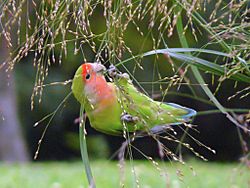 |
|
| A feral Rosy-faced Lovebird eating seeds in Chicago, USA | |
| Scientific classification | |
| Kingdom: | |
| Phylum: | |
| Class: | |
| Order: | |
| Superfamily: | |
| Family: |
Psittaculidae
|
| Subfamily: |
Agapornithinae
|
| Genus: |
Agapornis
|
Lovebirda, genus Agapornis, are a type of parrot. There are nine species. They are a social and affectionate small parrot. Seven species are native to Africa, and the Grey-headed Lovebird is native to Madagascar.
Their common name comes from the parrots' strong, monogamous pair bonding and the long time the pairs spend sitting together. Lovebirds live in small flocks and eat fruit, vegetables, grass and seeds. Black-winged Lovebirds also eat insects and figs, and the Black-collared Lovebirds have a special dietary requirement for native figs, making them more difficult to keep in captivity.
Species
| Species (wild-types) | |||
|---|---|---|---|
| Common and binomial names | Photograph | Description | Range |
| Yellow-collared lovebird or masked lovebird (Agapornis personatus) |
 |
14 cm (5.5 in) long. Yellow and green. Has blue tail feathers. | Northeast Tanzania |
| Fischer's lovebird (Agapornis fischeri) |
 |
14 cm (5.5 in) long. Mostly green, orange upper body and head, blue lower back and rump, red beak, white eyerings | South and southeast of Lake Victoria in northern Tanzania |
| Lilian's lovebird or Nyasa lovebird (Agapornis lilianae) |
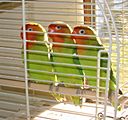 |
13 cm (5 in) long. Mostly green including green back and green rump, orange head, red beak, white eyerings | Malawi |
| Black-cheeked lovebird (Agapornis nigrigenis) |
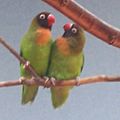 |
14 cm (5.5 in) long. Mostly green, brownish-black cheeks and throat, reddish-brown forehead and forecrown, orange upper chest, red beak, white eyerings | Zambia |
| Peach-faced lovebird or rosy-faced lovebird (Agapornis roseicollis) |
 |
15 cm (6 in) long. Mostly green, orange face, blue lower back and rump, horn-coloured beak | Angola, Botswana, Namibia, South Africa |
| Black-winged lovebird or Abyssinian lovebird (Agapornis taranta) |
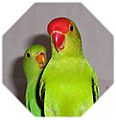 |
16.5 cm (6.5 in) long. Mostly green, red beak, some black wing feathers. Sexual dimorphism: only the male has red on forehead and crown, female's plumage is all green | Southern Eritrea to southwestern Ethiopia |
| Red-headed lovebird or red-faced lovebird (Agapornis pullarius) |
 |
15 cm (6 in) long. Mostly green with red on upper neck and face. Sexual dimorphism: the male has more extensive and a darker red on face and head, and the male has a darker red beak than the female | Large part of central Africa |
| Grey-headed lovebird or Madagascar lovebird (Agapornis canus) |
 |
13 cm (5 in) long. Mostly green with darker green on back, pale grey beak. Sexual dimorphism: male has a grey upper body, neck and head. | Madagascar |
| Black-collared lovebird or Swindern's lovebird (Agapornis swindernianus) |
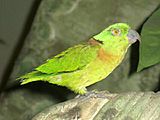 |
13.5 cm (5 in) long. Mostly green, brown collar which has a black upper margin at the back of the neck, dark grey/black beak | Equatorial Africa |
Images for kids
-
A yellow-collared lovebird perching by the entrance to a nest box in a large aviary at the Honolulu Zoo, Hawaii, USA
See also
 In Spanish: Inseparables para niños
In Spanish: Inseparables para niños

All content from Kiddle encyclopedia articles (including the article images and facts) can be freely used under Attribution-ShareAlike license, unless stated otherwise. Cite this article:
Lovebird Facts for Kids. Kiddle Encyclopedia.


